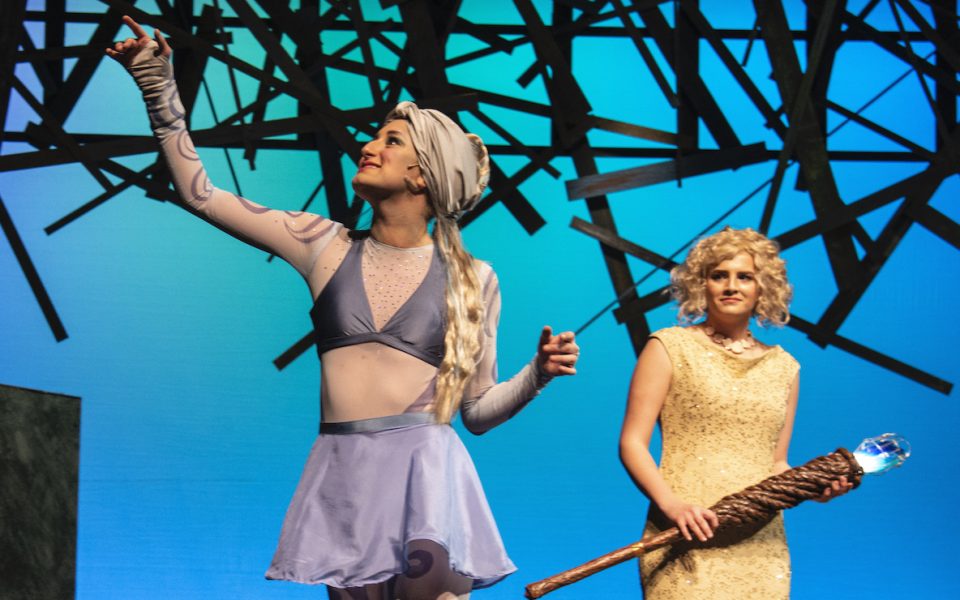It
begins with a crash.
Lightning
cuts through the fog as a captain struggles to hold the wheel of the ship. The
passengers run about, grabbing onto any solid object to keep them upright. Suddenly,
a spirit dressed in blue wisps past each of them, the air knocking them over
and capsizing their boat.
UNCG’s
School of Theatre opened a two-weekend run of the Tempest on Jan. 14. The story follows a shipwreck onto an
island full of spirits, run by a sorcerer, as the magic of the island brings
everyone closer.
The
company kept the story’s stormy entrance, but pulled Shakespeare’s play into a
more modern setting, dropping it firmly in 1957. Twisting the bard’s work a bit
further, the company opened many of the male roles to women, making for a
mother-daughter tale with Prospera at the center.

The
show serves as MFA student Ashley Sarver’s thesis production. Acting behind the
scenes as both director and composer, Sarver made a few alterations with her
crew. In 1957, the aftermath of WWII and the approaching Cold War informed the
island. Magician’s robes become a silky shawl and a wide-brimmed hat, while the
spirits that haunt the island become beatniks in circle, wearing sunglasses and
turtlenecks. After changing the main character from Prospero to Prospera, the
rest of the cast became a sort of gender-bending free-for-all, opening up a
male-dominated play to many of the female actors of the school.
“It
was more actor-informed casting,” Sarver said. “It was about who could tell the
story the best.”
The
changes helped actors Carla Dale Fuller and Maddie Conti learn the story. In
their first Shakespeare experience, the two took the roles of Prospera and
Ariel respectively.
Fuller
and Conti found that honing in on the meanings behind the Bard’s Elizabethan
dialect helped to guide their performance.
“It
was vital that we knew what every single person was saying or going through,”
Conti said.
The
original play, filled with iambic pentameter and intermittent songs for Ariel’s
magic, carries even more rhythm and musicality than some of the Bard’s other
work. UNCG’s School of Theatre challenges the limits, taking the era of jazz
and the beginnings of rock as influences.
“I
think a really big part of it was that the music really fit the story,” Fuller
said.
The
spirits, clad in unmatching patterns, wide-legged pants and black clothing,
roam about. They tap on bongos, or play a few notes on a saxophone as the
shipwrecked characters explore the island. A snap or two interrupts
conversations, and Conti improvs scat singing as Ariel lulls the shipwreck’s survivors
to sleep, or lures Ferdinand further into the forest.

On
one side of the stage, a pile of platforms reach up. The shape becomes an
island’s side for the ship to crash into, or a cliff for the characters to
climb. In one scene, it acts as a scattering of rocks and shipwreck on the
shore. In another, it acts as a hill for the characters to hide upon. Sound
Designer Andrew Crews explained that as characters walk by, certain open/close
switches helped the formation act just like a pair of drums or tambourine.
“We
were then able to play the island,” Crews said.
When
formal music isn’t playing, sound effects in the form of distorted, pulsating
noises emit from the stage. Rather than coming from an instrument, however, the
music is sneakily hidden inside the largest rock on the stage.
Behind
the music and the sound effects, a singular, irregular tone pulsates. Crews
explained the idea came from a musicalization of gamma ray radiation done by
NASA. It sets everything off, from thundering during the storm, to symbolizing
the end of Prospera’s magical obsession, all in the background of humanity
discovering what power radiation could hold.
“Our
set,” Sarver said, “became a live instrument.”
UNCG’s production of the Tempest runs through Feb. 22nd. Find details at vpa.uncg.edu.
Join the First Amendment Society, a membership that goes directly to funding TCB‘s newsroom.
We believe that reporting can save the world.
The TCB First Amendment Society recognizes the vital role of a free, unfettered press with a bundling of local experiences designed to build community, and unique engagements with our newsroom that will help you understand, and shape, local journalism’s critical role in uplifting the people in our cities.
All revenue goes directly into the newsroom as reporters’ salaries and freelance commissions.


Leave a Reply